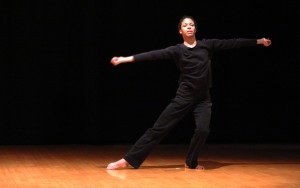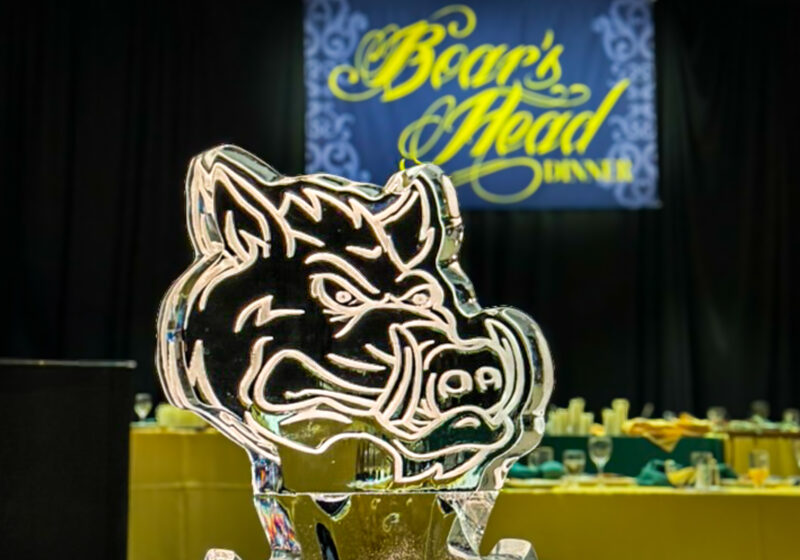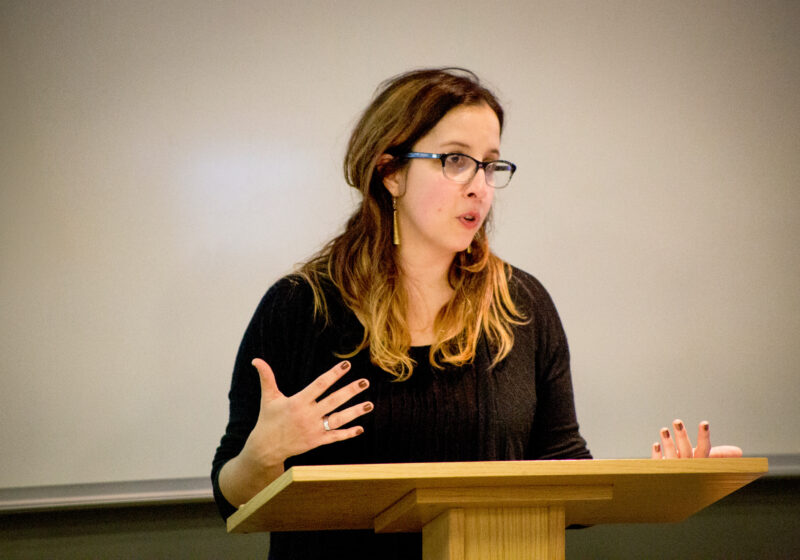
A member of Heidi Latsky Dance performed under the spotlight as part of inspireDANCE on Friday, Feb. 17.
Heidi Latsky Dance, a dance troupe based out of New York City, performed to a packed audience in the Spurrier Dance Studio on Friday, Feb. 17. The show was part of UR’s inspireDANCE Festival, founded last year by former Kauffman Entrepreneurial Year (KEY) Scholar Arielle Friedlander ’11 to great critical success. The triumph continued this year as tickets to events were sold out within a few days of going on sale.
The show started with a video trailer about Heidi Latsky’s GIMP project, which features physically handicapped dancers alongside non-handicapped dancers. According to this video, the project’s aim is to “confront the audience with their preconceptions, challenging us to re-think accepted notions about dance, performance and body image.”
The show consisted of two movements which are excerpts of larger dance pieces currently under development. The first movement, “Solo Countersolo,” featured Latsky wearing an all-black outfit as she danced under the spotlight.
Her movements were direct and strong while facing the audience. The music connected perfectly with the beat and tempo of the dance. As the speed of the music increased, her movements matched the tempo until it became a dizzying whirlwind of motion.
The second half of “Solo Countersolo” consisted of three dancers, dressed in black, dancing to an instrumental score by Chris Brierley, a composer who works on a myriad of projects including films, advertising and, of course, dance troupes.
A majority of the movements consisted of classical ballet jumps and spins with clear and defined movements. The dancers moved over the entire stage, although it seemed too big of a space for only three dancers. It created a lack of focus, since the audience had to keep an eye on all the dancers, an issue made even more problematic due to the fact that they were all equally fascinating to watch.
The movements, in conjunction with the music, created a sense of detachment for the audience. It felt like intruding upon a dance rehearsal from a long begotten era of classical dance — an era in which technique and execution was the sole purpose of dance and to display any obvious show of emotion was regarded as an inferior form.
The second excerpt, “Somewhere”, included an additional dancer and was the antithesis of the previous movement. One of the biggest changes was the music, which was a variety of classical feel-good songs such as “Over the Rainbow” by Israel Kamakawiwo’ole.
The dancers were paired and the movement was modern and fluid. Just when the audience thought the paired dancers were going to dance in synchrony the entire time, there was a sudden variation of movement to recapture its initial interest.
Whereas the previous movement was devoid of emotion, this movement definitely expressed a sense of hope and joy. The first pair of dancers were Erica Moshman and Jerron Herman, who danced with their left hands curled up the entire time to signify a physically disabled hand.
The second pair were Jillian Hollis and Melani Hailey, who had a back and forth dance mêlée which was direct and emotional.The last dance in this movement featured a solo in which Herman danced as if he was suddenly affected by a movement disorder.
His jerky movements were impossibly fast, but still clearly defined as a movement sequence. This was, no doubt, influenced by his of cerebral palsy diagnosis, which he received at the age of three.
These dances did a fantastic job spotlighting the movements caused by disability or disease as a celebration of acceptance and pride instead of hidden shame.
After the show, all five dancers sat down in front of the audience to answer questions. This helped to clarify some confusion that came up during the performance.
For example, they explained that the second movement seemed unnecessarily spread out because the dance calls for eight to 10 performers, rather than the three that danced in Spurrier.Additionally, having the dancers talk about their backgrounds and their journeys in the dance world brought a sense of humanity to the performance.
The entire Program of Dance and Movement is to be congratulated for putting together their second annual inspireDANCE Festival. Though dance may not necessarily come to mind when one thinks of UR just yet, things like the inspireDANCE festival, performances like Latsky’s and other such events are well on their way to changing that.
Chen is a member of the class of 2012.



